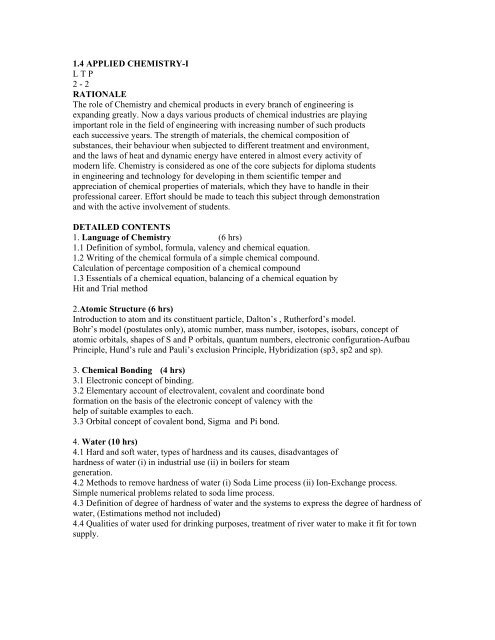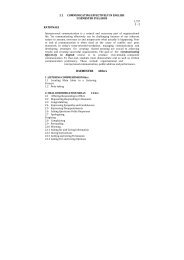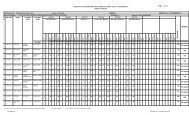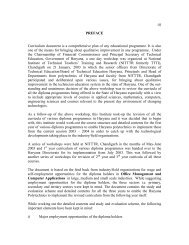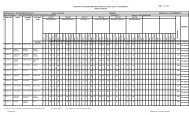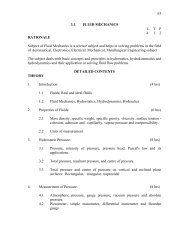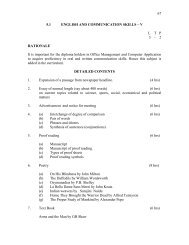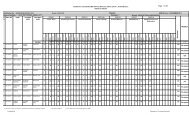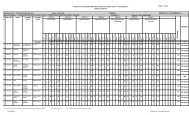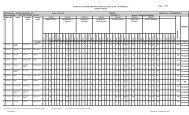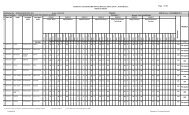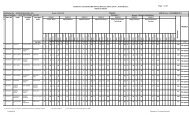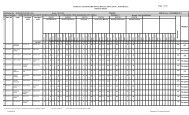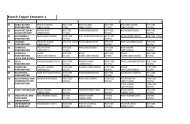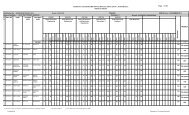1.4 APPLIED CHEMISTRY-I L T P 2 - 2 RATIONALE The role ... - hsbte
1.4 APPLIED CHEMISTRY-I L T P 2 - 2 RATIONALE The role ... - hsbte
1.4 APPLIED CHEMISTRY-I L T P 2 - 2 RATIONALE The role ... - hsbte
You also want an ePaper? Increase the reach of your titles
YUMPU automatically turns print PDFs into web optimized ePapers that Google loves.
<strong>1.4</strong> <strong>APPLIED</strong> <strong>CHEMISTRY</strong>-IL T P2 - 2<strong>RATIONALE</strong><strong>The</strong> <strong>role</strong> of Chemistry and chemical products in every branch of engineering isexpanding greatly. Now a days various products of chemical industries are playingimportant <strong>role</strong> in the field of engineering with increasing number of such productseach successive years. <strong>The</strong> strength of materials, the chemical composition ofsubstances, their behaviour when subjected to different treatment and environment,and the laws of heat and dynamic energy have entered in almost every activity ofmodern life. Chemistry is considered as one of the core subjects for diploma studentsin engineering and technology for developing in them scientific temper andappreciation of chemical properties of materials, which they have to handle in theirprofessional career. Effort should be made to teach this subject through demonstrationand with the active involvement of students.DETAILED CONTENTS1. Language of Chemistry (6 hrs)1.1 Definition of symbol, formula, valency and chemical equation.1.2 Writing of the chemical formula of a simple chemical compound.Calculation of percentage composition of a chemical compound1.3 Essentials of a chemical equation, balancing of a chemical equation byHit and Trial method2.Atomic Structure (6 hrs)Introduction to atom and its constituent particle, Dalton’s , Rutherford’s model.Bohr’s model (postulates only), atomic number, mass number, isotopes, isobars, concept ofatomic orbitals, shapes of S and P orbitals, quantum numbers, electronic configuration-AufbauPrinciple, Hund’s rule and Pauli’s exclusion Principle, Hybridization (sp3, sp2 and sp).3. Chemical Bonding (4 hrs)3.1 Electronic concept of binding.3.2 Elementary account of electrovalent, covalent and coordinate bondformation on the basis of the electronic concept of valency with thehelp of suitable examples to each.3.3 Orbital concept of covalent bond, Sigma and Pi bond.4. Water (10 hrs)4.1 Hard and soft water, types of hardness and its causes, disadvantages ofhardness of water (i) in industrial use (ii) in boilers for steamgeneration.4.2 Methods to remove hardness of water (i) Soda Lime process (ii) Ion-Exchange process.Simple numerical problems related to soda lime process.4.3 Definition of degree of hardness of water and the systems to express the degree of hardness ofwater, (Estimations method not included)4.4 Qualities of water used for drinking purposes, treatment of river water to make it fit for townsupply.
5. Solutions (8 hrs.)5.1 Concept of homogeneous solution (i) Colloids (ii) Suspensions (iii) Brownian Movement (iv)Osmosis (v) Acidity (vi) Basicity (vii) Equivalent weight and gram equivalent weight withsuitable examples (viii) Mole (ix) Avogadro number (x) pH (xi) Industrial application of pH5.2 Strength of a solution (i) Normality (ii) Molarity (iii) Molality as applied in relation to asolution.5.3 Simple numerical problems related to volumetric analysis.6. Electrolysis (6 hrs)6.1 Definition of the terms: Electrolytes, Non-electrolytes conductors andnon-conductors with suitable examples6.2 Faraday’s Laws of Electrolysis6.3 Simple numerical problems based upon the laws of electrolysis6.4 Different industrial applications of ‘Electrolysis’6.5 Elementary account of (i) lead acid battery and (ii) Ni-Cd batteryLIST OF PRACTICALS1. Volumetric analysis and study of apparatus used therein.2. Preparation of standard solution of oxalic acid or potassium dichromate3. Determine the strength of a given solution of sodium hydroxide with the helpof a standard solution of oxalic acid4. Determine the strength of solution of HCl with the help of a solution of NaOHand an intermediate solution of standard oxalic acid5. Estimation of total alkalinity of water volumetrically6. Determine, pH of water sample using pH meterRECOMMENDED BOOKS1. “A Text Book of Applied Chemistry-I” by SS Kumar; Tata McGraw Hill,Delhi.2. Chemistry in Engineering by J.C. Kuriacose and J. Rajaram; Tata McGraw-Hill Publishing Company Limited, New Delhi3. Engineering Chemistry by Dr. S. Rabindra and Prof. B.K. Mishra ; Kumar andKumar Publishers (P) Ltd. Bangalore-40Other additional Books for Reading1. Engineering Chemistry by Jain PC and Jain M2. Chemistry of Engineering by Aggarwal CV3. Chemistry for Environmental Engineers by Swayer and McCarty, McGrawHill, Delhi4. Progressive Applied Chemistry –I and II by Dr. G.H. Hugar; Eagle Prakashan,Jalandhar
2.4 <strong>APPLIED</strong> <strong>CHEMISTRY</strong>-IIL T P2 - 2<strong>RATIONALE</strong><strong>The</strong> <strong>role</strong> of Chemistry and chemical products in every branch of engineering is expandinggreatly. Now a days various products of chemical industries are playing important <strong>role</strong> inthe field of engineering with increasing number of such products each successive years.<strong>The</strong> strength of materials, the chemical composition of substances, their behaviour whensubjected to different treatment and environment, and the laws of heat and dynamicenergy have entered in almost every activity of modern life. Chemistry is considered asone of the core subjects for diploma students in engineering and technology fordeveloping in them scientific temper appreciation of chemical properties of materials,which they have to handle in their professional career. Effort should be made to teach thissubject through demonstration and with the active involvement of students.DETAILED CONTENTS1. Metallurgy (10 hrs)1.1 A brief introduction of the terms: Metallurgy (types), mineral, ore, gangueor matrix, flux, slag, concentration (methods of concentrating the ores),roasting calcination and refining as applied in relation to variousmetallurgical operations1.2 Metallurgy of (i) Aluminium (ii) Iron (iii) copper with their physical and chemicalProperties.1.3 Definition of an alloy, purposes of alloying, composition, properties anduses of alloys-brass, bronze, monel metal, magnalium, duralumin.2. Fuels (10 hrs)2.1 Definition of a ‘Fuel’, characteristics of a good fuel and classification offuels with suitable examples2.2 Definition of Calorific value of a fuel and determination of calorific valueof a liquid fuel with the help of Bomb calorimeter. Simple numericalproblems based upon Bomb-calorimeter method of finding the Calorificvalues2.3 Brief description of ‘Proximate’ and ‘Ultimate’ analysis of a fuel.Importance of conducting the proximate and ultimate analysis of a fuel2.4 Qualities of a good fuel and merits of gaseous fuels over those of othervarieties of fuels2.5 Manufacture, composition, properties and uses of (i) Water gas (ii) Oil gas(iii) Biogas (iv) LPG (V) CNG3 Corrosion (3 hrs)3.1 Meaning of the term ‘corrosion’ and its definition3.2 <strong>The</strong>ories of corrosion i.e. (i) direct chemical action theory and (ii) electrochemical theory3.3 Prevention of corrosion by1. (a) Alloying(b) Providing metallic coatings2. Cathodic protections:(a) Sacrificial(b) Impressed voltage method4 Lubricants (4 hrs)4.1 Definition of (i) lubricant (ii) lubrication
4.2 Classification of lubricants4.3 Principles of lubrication(i) fluid film lubrication(ii) boundary lubrication(iii) extreme pressure lubrication4.4 Characteristics of a lubricant such as viscosity, viscosity index, volatilityoiliness, acidity, emulsification, flash point and fire point and pour point.5. Classification and Nomenclature of Organic Compounds (7 hrs)5.1 Homologous series5.2 IUPAC Nomenclature of Hydrocarbons ,Alcohols, Aldehydes and Ketones & Carboxylic acids5.3 Hydrocarbons (Alkanes, Alkenes and Alkynes)-general preparation, Chemical properties anduses.5.4 Alcohols (Diols and Triols not included)-general preparation, Chemical properties and uses.5.5 Aldehydes and Ketones preparation properties and uses.5.6 Monocarboxlic acids-general preparation, chemical properties and uses6 Rubber and Polymers (2 hrs)6.1 Definition of Rubber and Polymers6.2 Types of Rubber6.3 Classification of Polymers6.4 Composition and uses of Polythene, PVC, Teflon, Bakelite.LIST OF PRACTICALS1. Gravimetric analysis and study of apparatus used there in2. To determine the percentage composition of a mixture consisting of a volatile anda non-volatile substances3. Determine the viscosity of a given oil with the help of “Redwood viscometer”4. Estimate the amount of ash in the given sample of coal5. Determination of copper in the given brass solution, or sample of blue vitriolvolumetrically6 Electroplate the given strip of Cu with Ni7. Detection of organic compounds (Aldehydes, Ketones, Carboxylic acid, and Amines)RECOMMENDED BOOKS1. “A Text Book of Applied Chemistry-I” by SS Kumar; Tata McGraw Hill, Delhi2. Chemistry in Engineering by J.C. Kuriacose and J. Rajaram; Tata McGraw-HillPublishing Company Limited, New Delhi3. Engineering Chemistry by Dr. S. Rabindra and Prof. B.K. Mishra ; Kumar andKumar Publishers (P) Ltd. Bangalore-40Other additional books for reading1. Engineering Chemistry by Jain PC and Jain M2. Chemistry of Engineering by Aggarwal CV3. Chemistry for Environmental Engineers by Swayer and McCarty, McGraw Hill,Delhi4. Progressive Applied Chemistry –I and II by Dr. G.H. Hugar; Eagle Prakashan,Jalandhar


